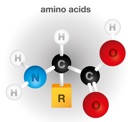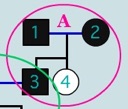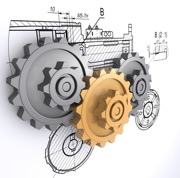 Understanding the cellular roles of DNA and protein is challenging because they are, in important and meaningful ways, not analogous to anything in the macroscopic world. Proteins are a fascinating study: while cars, watches and houses are built by specialized builders, a single master factory, the ribosome, strings together all cellular proteins. And in a richly meaningful sense, that string then assembles itself (folds) into its final form. And the machines of the cell are almost unimaginably diverse in their forms and functions, the latter of which derive once again from within: the amino acid building blocks and precisely where they come to rest in the final three dimensional structure.
Understanding the cellular roles of DNA and protein is challenging because they are, in important and meaningful ways, not analogous to anything in the macroscopic world. Proteins are a fascinating study: while cars, watches and houses are built by specialized builders, a single master factory, the ribosome, strings together all cellular proteins. And in a richly meaningful sense, that string then assembles itself (folds) into its final form. And the machines of the cell are almost unimaginably diverse in their forms and functions, the latter of which derive once again from within: the amino acid building blocks and precisely where they come to rest in the final three dimensional structure.
AP Biology - 2. page
Plea for pedigrees: pedigree deduction in Introductory Biology
 Pedigree-solving can be perceived as passé in an era in which every single nucleotide of an individual’s genome can be learned (relatively) affordably, parents be damned. But I don’t think that’s the value in teaching pedigree deduction; indeed, I question whether it ever should have been. As with many exercises in Introductory Biology, I think we need to make careful distinctions between means and ends. Pedigree deduction can be employed as one of a class of near-perfect problem-solving opportunities, employing limited, easy-to-grasp tools, reflecting core biology (meiosis, randomness), and representing an unforgiving series of clear deductions. To my mind, the question should be how do we make sure these aspects are represented in tasks and assessments involving pedigrees.
Pedigree-solving can be perceived as passé in an era in which every single nucleotide of an individual’s genome can be learned (relatively) affordably, parents be damned. But I don’t think that’s the value in teaching pedigree deduction; indeed, I question whether it ever should have been. As with many exercises in Introductory Biology, I think we need to make careful distinctions between means and ends. Pedigree deduction can be employed as one of a class of near-perfect problem-solving opportunities, employing limited, easy-to-grasp tools, reflecting core biology (meiosis, randomness), and representing an unforgiving series of clear deductions. To my mind, the question should be how do we make sure these aspects are represented in tasks and assessments involving pedigrees.
A mechanistic view of the cell: the glory of because
 Introductory biology can be overwhelming; what we consider to be ‘essential foundation’ could take up an entire undergraduate education. This issue is compounded when we treat the body of knowledge as a collection of names and facts (or when students achieve this view despite our efforts). By viewing the cell as a functioning machine, divided into compartments filled tasks performed by mindless but efficient mechanisms, a course can focus on understanding. A natural framework for student study and learning arises: the mechanics of the cell
Introductory biology can be overwhelming; what we consider to be ‘essential foundation’ could take up an entire undergraduate education. This issue is compounded when we treat the body of knowledge as a collection of names and facts (or when students achieve this view despite our efforts). By viewing the cell as a functioning machine, divided into compartments filled tasks performed by mindless but efficient mechanisms, a course can focus on understanding. A natural framework for student study and learning arises: the mechanics of the cell
Evolution in Introductory biology: cell/molecular semester
 Many institutions divide Introductory Biology into Cell/Molecular and Ecology/Evolution semesters. There is some sense to this, in that one scale can be seen as cellular and smaller, the other organismal and larger. However, failing to weave the influences, evidences and implications of evolution into the cell-molecular semester wastes an opportunity to show students through our teaching of these topics how central these ideas are. Further, there are a wonderful molecular examples that represent powerful, approachable proofs and demonstrate to students what they can do if they pick up these tools.
Many institutions divide Introductory Biology into Cell/Molecular and Ecology/Evolution semesters. There is some sense to this, in that one scale can be seen as cellular and smaller, the other organismal and larger. However, failing to weave the influences, evidences and implications of evolution into the cell-molecular semester wastes an opportunity to show students through our teaching of these topics how central these ideas are. Further, there are a wonderful molecular examples that represent powerful, approachable proofs and demonstrate to students what they can do if they pick up these tools.
What’s important about… Key Concepts in Biology
Before we design courses, textbooks, assessments, labs, we need to determine what is important to teach in Introductory Biology. I think we’ve failed to do that, or at the very least confused concepts with content. Part of the problem is historical–textbooks are a product of inertia, each new one modeled on the ones that came before rather than initiated de novo to reflect principles in biology or pedagogy. Secondarily, I think a lot of effort in revamping biology curricula is being driven by older efforts in Chemistry and Physics, where a lot of the critical material is more operational and less conceptual. I’m writing this post to lay out one possible schema.
in Introductory Biology. I think we’ve failed to do that, or at the very least confused concepts with content. Part of the problem is historical–textbooks are a product of inertia, each new one modeled on the ones that came before rather than initiated de novo to reflect principles in biology or pedagogy. Secondarily, I think a lot of effort in revamping biology curricula is being driven by older efforts in Chemistry and Physics, where a lot of the critical material is more operational and less conceptual. I’m writing this post to lay out one possible schema.
PatternMaster: Real Scientific Method
Sitting in a classroom, a beginning biology student can easily come away with the impression that the Joy of Science lies in memorizing what is already known… and that historical problem solving and experimentation was about confirming what was obvious or inevitable. This describes no one I have ever worked with, and no lab I’ve ever worked in. The challenge is in delivering the excitement of figuring things out; too many labs are about taking (often stale) data.
PatternMaster (now playable via web/tablet!) lets students make discoveries about how things work using the Scientific Method. To quote the NGSS ‘Crosscutting concepts’:
1. Patterns. Observed patterns of forms and events guide organization and classification, and they prompt questions about relationships and the factors that influence them.
- « Previous
- 1
- 2
- 3
- Next »
